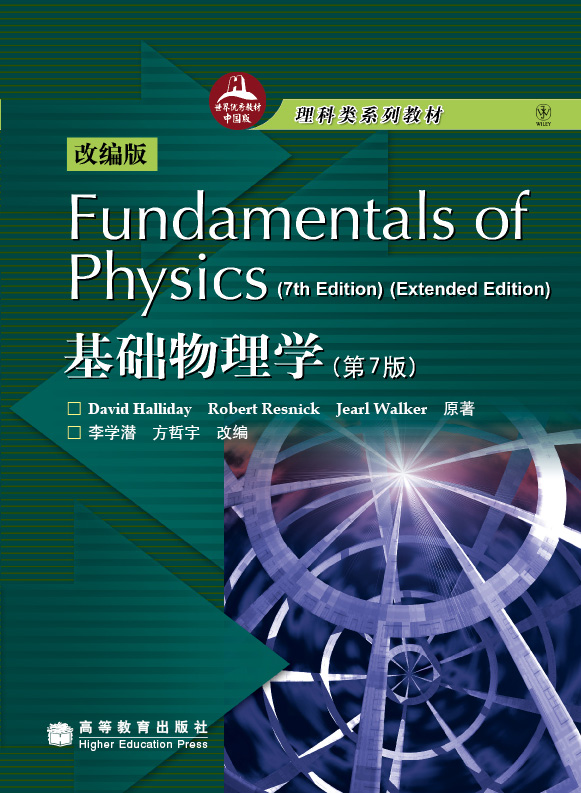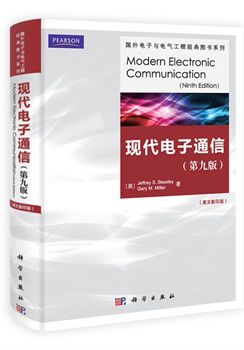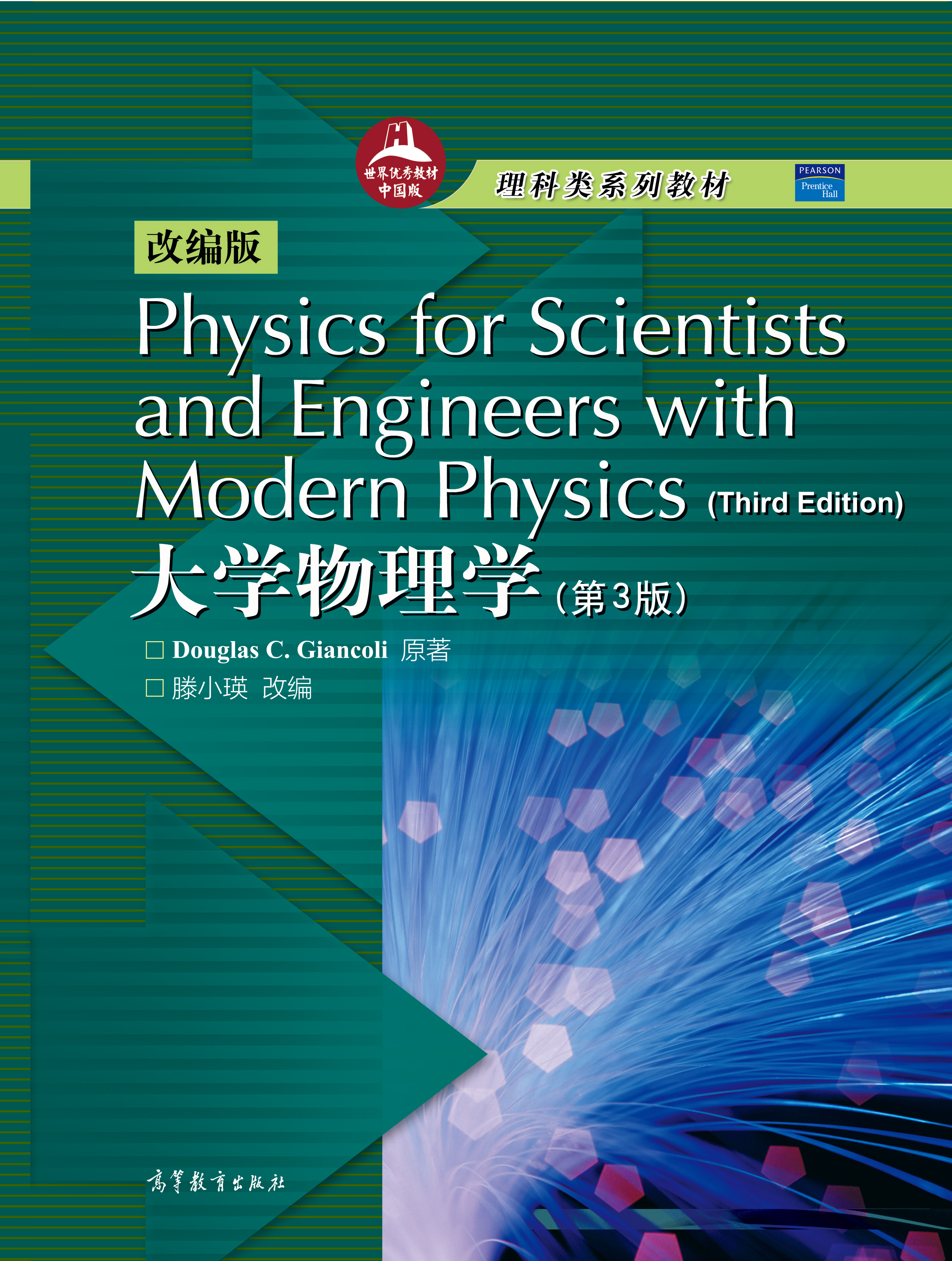基础物理学(第7版)(改编版)
作者: Halliday
出版时间:2008-06
出版社:高等教育出版社
- 高等教育出版社
- 9787040228649
- 7版
- 163185
- 48262123-2
- 平装
- 大16开
- 2008-06
- 1300
- 827
- 理学
- 物理学类
- O4
- 工学
- 本科
本书是哈里德等人编写的Fundamentals of physics(7th Edition)的改编版。
哈里德一书是一套典型的美国教材,在我国也有很高的知名度。原书物理原理阐述通俗易懂,图文并茂内容丰富。编者在改编时保持了原作的风格和特色,根据国内高校教学的基本特点,系统地阐述了力学、热学、光学、电磁学等基本规律和基本概念,并初步介绍了相对论原理、原子物理、半导体物理等近现代物理内容。删掉与中学物理重复的部分,使整体内容紧凑合理,并在每章末尾安排了较多的思考题和习题,使本书在理工科教学中更具有实用性,普适性。本书可作为高等学校物理专业基础课双语教材,也可供其他理工科类专业有关教师、学生参考。
1 Measurement
1-1 What Is Physics?
1-2 Measuring Things
1-3 The International System of Units
1-4 Changing Units
1-5 Length
1-6 Time
1-7 Mass
Problems
2 Motion
2-1 What Is Physics?
2-2 Vectors and Scalars
2-3 Multiplying Vectors
2-4 Motion
2-5 Position and Displacement
2-6 Average Velocity and Instantaneous Velocity
2-7 Acceleration
2-8 Constant Acceleration: A Special Case
2-9 Graphical Integration in Motion Analysis
2-10 Projectile Motion
2-11 Projectile Motion Analyzed
2-12 Uniform Circular Motion
2-13 Relative Motion
Questions
Problems
3 Force
3-1 What Is Physics?
3-2 Newtonian Mechanics
3-3 Newton’s First Law
3-4 Force
3-5 Mass
3-6 Newton’s Second Law
3-7 Newton’s Third Law
3-8 Applying Newton’s Laws
3-9 Some Particular Forces
3-10 Friction
3-11 The Drag Force and Terminal Speed
3-12 Uniform Circular Motion
Questions
Problems
4 Energy and Work
4-1 What Is Physics?
4-2 What Is Energy?
4-3 Kinetic Energy
4-4 Work
4-5 Work and Kinetic Energy
4-6 Work Done by the Force
4-7 Power
4-8 Work and Potential Energy
4-9 Path Independence of Conservative Forces
4-10 Determining Potential Energy Values
4-11 Conservation of Mechanical Energy
4-12 Work Done on a System by an External Force
4-13 Conservation of Energy
Questions
Problems
5 Center of Mass and Linear Momentum
5-1 What Is Physics?
5-2 The Center of Mass
5-3 Newton’s Second Law for a System of Particles
5-4 Linear Momentum
5-5 The Linear Momentum of a System of Particles
5-6 Collision and Impulse
5-7 Conservation of Linear Momentum
5-8 Momentum and Kinetic Energy in Collisions
5-9 Inelastic Collisions in One Dimension
5-10 Elastic Collisions in One Dimension
5-11 Collisions in Two Dimensions
5-12 Systems with Varying Mass: A Rocket
Questions
Problems
6 Rotation and Angular Momentum
6-1 What Is Physics?
6-2 Equilibrium
6-3 The Rotational Variables
6-4 Are Angular Quantities Vectors?
6-5 Relating the Linear and Angular Variables
6-6 Kinetic Energy of Rotation
6-7 Calculating the Rotational Inertia
6-8 Newton’s Second Law for Rotation
6-9 Work and Rotational Kinetic Energy
6-10 Rolling as Translation and Rotation Combined
6-11 The Kinetic Energy of Rolling
6-12 The Forces of Rolling
6-13 Torque Revisited
6-14 Angular Momentum
6-15 Newton’s Second Law in Angular Form
6-16 The Angular Momentum of a System of Particles
6-17 The Angular Momentum of a Rigid Body Rotating About a Fixed Axis
6-18 Precession of a Gyroscope
Questions
Problems
7 Gravitation
7-1 What Is Physics?
7-2 Newton’s Law of Gravitation
7-3 Gravitation and the Principle of Superposition
7-4 Gravitation Near Earth’s Surface
7-5 Gravitation Inside Earth
7-6 Gravitational Potential Energy
7-7 Planets and Satellites: Kepler’s Laws
7-8 Satellites: Orbits and Energy
7-9 Einstein and Gravitation
Questions
Problems
8 Oscillations
8-1 What Is Physics?
8-2 Simple Harmonic Motion
8-3 The Force Law for Simple Harmonic Motion
8-4 Energy in Simple Harmonic Motion
8-5 An Angular Simple Harmonic Oscillator
8-6 Pendulums
8-7 Simple Harmonic Motion and Uniform Circular Motion
8-8 Damped Simple Harmonic Motion
8-9 Forced Oscillations and Resonance
Questions
Problems
9 Waves
9-1 What Is Physics?
9-2 Types of Waves
9-3 Transverse and Longitudinal Waves
9-4 Wavelength and Frequency
9-5 The Speed of Wave
9-6 Energy and Power of a Wave Traveling Along a String
9-7 The Wave Equation
9-8 Standing Waves
9-9 Sound Waves
9-10 Traveling Sound Waves
9-11 Interference
9-12 Intensity and Sound Level
9-13 Sources of Musical Sound
9-14 Beats
9-15 The Doppler Effect
9-16 Supersonic Speeds, Shock Waves
Questions
Problems
10 The Kinetic Theory of Gases
10-1 What Is Physics?
10-2 Avogadro’s Number
10-3 Ideal Gases
10-4 Pressure, Temperature, and RMS Speed
10-5 Translational Kinetic Energy
10-6 Mean Free Path
10-7 The Distribution of Molecular Speeds
10-8 The Molar Specific Heats of an Ideal Gas
10-9 Degrees of Freedom and Molar Specific Heats
10-10 A Hint of Quantum Theory
10-11 The Adiabatic Expansion of an Ideal Gas
Questions
Problems
11 The Law of Thermodynamics
11-1 What Is Physics?
11-2 Temperature
11-3 The Zeroth Law of Thermodynamics
11-4 Measuring Temperature
11-5 Thermal Expansion
11-6 The Absorption of Heat by Solids and Liquids
11-7 A Closer Look at Heat and Work
11-8 The First Law of Thermodynamics
11-9 Heat Transfer Mechanisms
11-10 Irreversible Processes and Entropy
11-11 Change in Entropy
11-12 The Second Law of Thermodynamics
11-13 Entropy in the Real World
11-14 A Statistical View of Entropy
Questions
Problems
12 Electricity
12-1 What Is Physics?
12-2 Electric Charge
12-3 Electric Field
12-4 A Point Charge in an Electric Field
12-5 A Dipole in an Electric Field
12-6 Electric Potential
12-7 Calculating the Potential from the Field
12-8 Electric Potential Energy
12-9 Potential of a Charged Isolated Conductor
Questions
Problems
13 Gauss’Law
13-1 What Is Physics?
13-2 Flux
13-3 Flux of an Electric Field
13-4 Gauss’Law
13-5 Gauss’Law and Coulomb’s Law
13-6 A Charged Isolated Conductor
13-7 Applying Gauss’Law: CylindricalSymmetry
13-8 Applying Gauss’Law: PlanarSymmetry
13-9 Applying Gauss’Law: SphericalSymmetry
Questions
Problems
14 DC Circuits
14-1 What Is Physics?
14-2 Capacitance
14-3 Capacitors in Parallel and in Series
14-4 Energy Stored in an Electric Field
14-5 Capacitor with a Dielectric
14-6 Electric Current
14-7 Resistance and Resistivity
14-8 Power in Electric Circuits
14-9 “Pumping” Charges
14-10 Calculating the Current in a Single-Loop Circuit
14-11 Multiloop Circuits
14-12 RC Circuits
Questions
Problems
15 Magnetic Fields
15-1 What Is Physics?
15-2 What Produces a Magnetic Field?
15-3 The Definition of B
15-4 Crossed Fields: Discovery of the Electron
15-5 Crossed Fields: The Hall Effect
15-6 A Circulating Charged Particle
15-7 Cyclotrons and Synchrotrons
15-8 Magnetic Force on a Current-Carrying Wire
15-9 Torque on a Current Loop
15-10 The Magnetic Dipole Moment
Questions
Problems
16 Magnetic Fields Due to Currents
16-1 What Is Physics?
16-2 Calculating the Magnetic Field Due to a Current
16-3 Force Between Two Parallel Currents
16-4 Ampere’s Law
16-5 Solenoids and Toroids Magnetic Field of a Solenoid
16-6 A Current-Carrying Coil as a Magnetic Dipole
Questions
Problems
17 Induction and Inductance
17-1 What Is Physics?
17-2 Two Experiments
17-3 Faraday’s Law of Induction
17-4 Lenz’s Law
17-5 Induction and Energy Transfers
17-6 Induced Electric Fields
17-7 Inductors and Inductance
17-8 Self-Induction
17-9 RL Circuits
17-10 Energy Stored in a Magnetic Field
17-11 Energy Density of a Magnetic Field
17-12 Mutual Induction
Questions
Problems
18 Electromagnetic Oscillations and Alternating Current
18-1 What Is Physics?
18-2 LC Oscillations, Qualitatively
18-3 The Electrical-Mechanical Analogy
18-4 LC Oscillations, Quantitatively
18-5 Damped Oscillations in an RLC Circuit
18-6 Alternating Current
18-7 Forced Oscillations
18-8 Three Simple Circuits
18-9 The Series RLC Circuit
18-10 Power in Alternating-Current Circuits
18-11 Transformers
Questions
Problems
19 Maxwell’s Equations; Magnetism of Matter
19-1 What Is Physics?
19-2 Gauss’Law for Magnetic Fields
19-3 Induced Magnetic Fields
19-4 Displacement Current
19-5 Maxwell’s Equations
19-6 Magnets
19-7 Magnetism and Electrons
19-8 Magnetic Materials
19-9 Diamagnetism
19-10 Paramagnetism
19-11 Ferromagnetism
Questions
Problems
20 Electromagnetic Waves
20-1 What Is Physics?
20-2 Maxwell’s Rainbow
20-3 The Traveling Electromagnetic Wave, Qualitatively
20-4 The Traveling Electromagnetic Wave, Quantitatively
20-5 Energy Transport and the Poynting Vector
20-6 Radiation Pressure
20-7 Polarization
20-8 Reflection and Refraction
20-9 Total Internal Reflection
20-10 Polarization by Reflection
Questions
Problems
21 Optics
21-1 What Is Physics?
21-2 Images
21-3 Thin Lenses
21-4 Optical Instruments
21-5 Light as a Wave
21-6 Diffraction
21-7 Diffraction by a Circular Aperture
21-8 Diffraction by a Double Slit
21-9 Diffraction Gratings
21-10 X-Ray Diffraction
21-11 Interference
21-12 Interference from Thin Films
21-13 Michelson’s Interferometer
Questions
Problems
22 Relativity
22-1 What Is Physics?
22-2 The Postulates
22-3 Measuring an Event
22-4 The Relativity of Simultaneity
22-5 The Relativity of Time
22-6 The Relativity of Length
22-7 The Lorentz Transformation
22-8 Some Consequences of the Lorentz Equations
22-9 The Relativity of Velocities
22-10 Doppler Effect for Light
22-11 A New Look at Momentum
22-12 A New Look at Energy
Questions
Problems
23 Quantum Physics
23-1 What Is Physics?
23-2 The Photon, the Quantum of Light
23-3 Electrons and Matter Waves
23-4 Schr?dinger’s Equation and Heisenberg’s Uncertainty Principle
23-5 Energies of a Trapped Electron One-Dimensional Traps
23-6 The Bohr Model of the Hydrogen Atom
23-7 Some Properties of Atoms
23-8 Angular Momenta and Magnetic Dipole Moments
23-9 The Stern-Gerlach Experiment
23-10 Magnetic Resonance
23-11 The Pauli Exclusion Principle
23-12 Building the Periodic Table
23-13 X Rays and the Ordering of the Elements
23-14 Lasers and Laser Light
Questions
Problems
24 Conduction of Electricity in Solids
24-1 What Is Physics?
24-2 The Electrical Properties of Solids
24-3 Insulators
24-4 Metals
24-5 Semiconductors
24-6 The p-n Junction
24-7 The Junction Rectifier
24-8 The Light-Emitting Diode (LED)
24-9 The Transistor
Questions
Problems
Appendices
A The International System of Units (SI)
B Some Fundamental Constants of Physics
C Some Astronomical Data
D Conversion Factors
E Mathematical Formulas
F Properties of the Elements
G Periodic Table of the Elements
Answers










